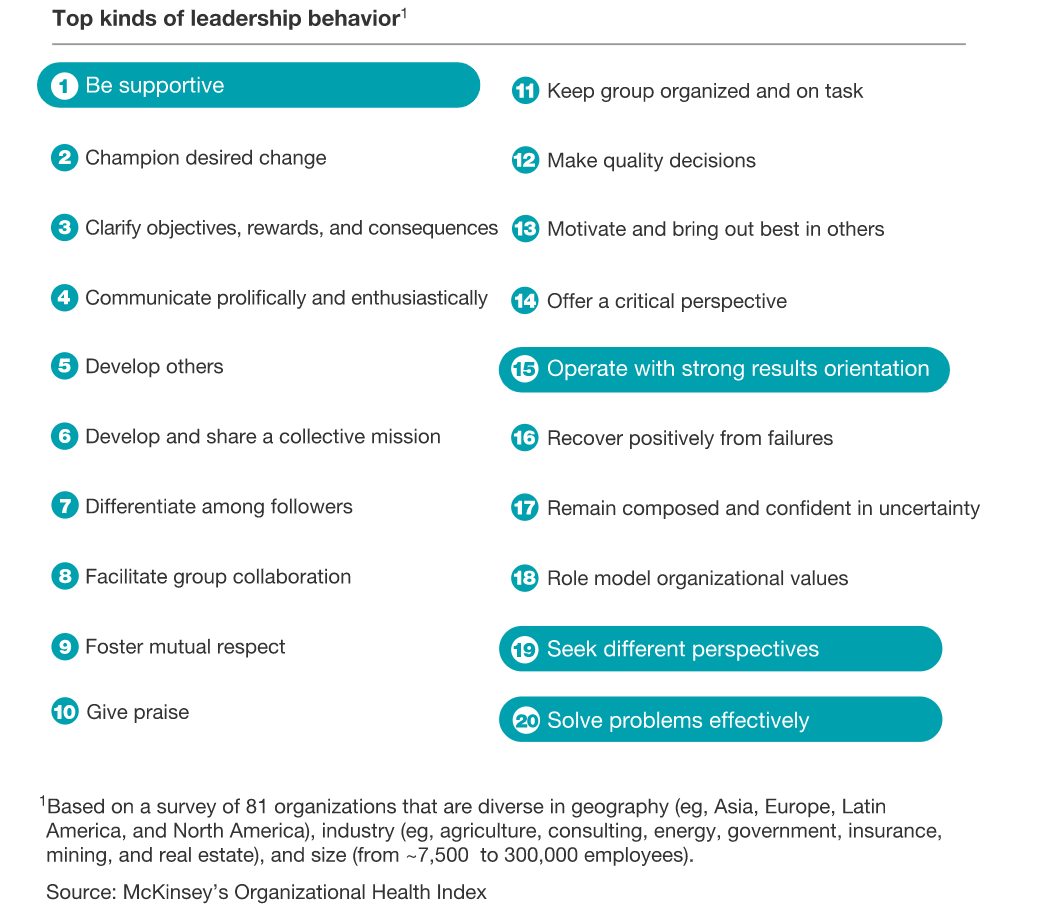Only good leadership can drive performance. This much has been obvious for long enough that CEOs are aware of the enormous importance of leadership development.
The great enigma remains, however, what type of leadership behavior should organizations encourage. Is it supposed to be approached contextually or are there standard definitions that apply (at least partially) to all situations? Should modern businesses place all their efforts towards rapid decision making, defining visions and developing leaders who have the ability to think on their feed and adapt quickly? Should communication and collaboration be the most important factors in choosing effective managers?
There is no consensus on the matter in the academic world and that makes it even harder for L&D specialists who have the daunting task of designing learning paths for new managers.
The top four skills of successful leaders
A recent McKinsey research, however, found that there are some very particular skills associated with leadership that correlates with business success. Starting from their previous experience in the field as well as browsing through the established academic literature, the researchers put together a list containing twenty distinct leadership traits, listed below:

The next step was to survey 189,000 people in 81 diverse organizations from around the globe to assess how frequently certain kinds of leadership behavior are applied within their organizations. Finally, the sample was divided into organizations whose leadership performance was strong (the top quartile of leadership effectiveness as measured by McKinsey's Organizational Health Index) and those that were weak (bottom quartile).
The results showed that leaders in organizations with high-quality leadership teams typically displayed 4 of the 20 possible types of behavior; these four actually accounted for 89 percent of the variance between strong and weak organizations in terms of leadership effectiveness. They are: solving problems effectively, operating with a strong results orientation, seeking different perspectives and supporting others.

-
Solving problems effectively
The process that precedes decision making is problem solving, when information is gathered, analyzed, and thoroughly considered. This is deceptively difficult to get right because, let’s face it, problems arise all the time and weather we choose to call them challenges in order to sweeten the semantics, they are never fun or easy to deal with.
Even if it’s a small issue or a bigger team dispute that has been festering for some time, an effective leader has to possess the capacity of dealing with it in a way that gets it solved and ensures it does not surface again. This skill is not necessarily one people are born with and this is an important aspect to be taken into consideration by the L&D professionals in charge with putting together the learning path for leaders.
However, theoretical knowledge covers just the base. New managers need to feel empowered and encouraged to dive into the issues and find appropriate solutions. These may not be the optimal ones to start with, yet in the long run practice will lead to valuable experience and quality results.
-
Operating with a strong results orientation
Leadership is about more than developing and communicating a vision and setting objectives. A successful company is one that manages to employ people who share in the vision and actually care about accomplishing corporate goals.
Leaders who exhibit a strong orientation towards results tend to emphasize the importance of efficiency and productivity and to prioritize the highest-value work. In order for a team to function efficiently, it needs to have a clear vision of where it needs to go and what the best road to take in that particular direction is.This should not be an issue since the leaders of tomorrow are part of the Millennial generation – one that is very practical and thrives on immediate gratification. However, it is important that organizations are very precise in defining the desired outcomes and the means by which these will be measured as well as make sure they celebrate success once it is achieved.
-
Seeking different perspectives
Diversity can only lead to progress. The modern business world is very dynamic and it is utterly impossible for one single person to know all there is to know and stay connected to all changes in trends.
Good leaders know to encourage and welcome different ideas from team members about how performance can be improved. They also have the capacity to discern about what issues are important and what are not and offer the appropriate weight to stakeholder concerns.
Leaders who do well on this dimension typically reach their decisions based on a sound analysis and do their best to avoid the many biases to which said decisions are prone. Hearing out everyone’s input on a matter is not a sign of indecisiveness but rather the mark of a secure leader who has great confidence in his team. Innovation is the motor that ensures the survival and general health of a business. -
Supporting others
It goes without saying that a good leader is one that people follow naturally and that only happens if they feel supported and appreciated. Managers who are supportive, understand and sense how other people feel are more successful. By being authentic and showing a sincere interest in those around them, they build trust and inspire and help colleagues to overcome challenges.
They lead by intervening in group work to promote organizational efficiency, they clear all misunderstandings and do their best to prevent team members’ energies from dissipating into internal conflicts. Since being accepted and getting along with everybody is so important it’s a good idea to promote managers from inside the organization rather than hiring new talent.
Although this one study does not completely answer the question of what leadership style organizations ought to nurture, it gives four very good starting points: focusing on developing these basic skills in their future leaders.







